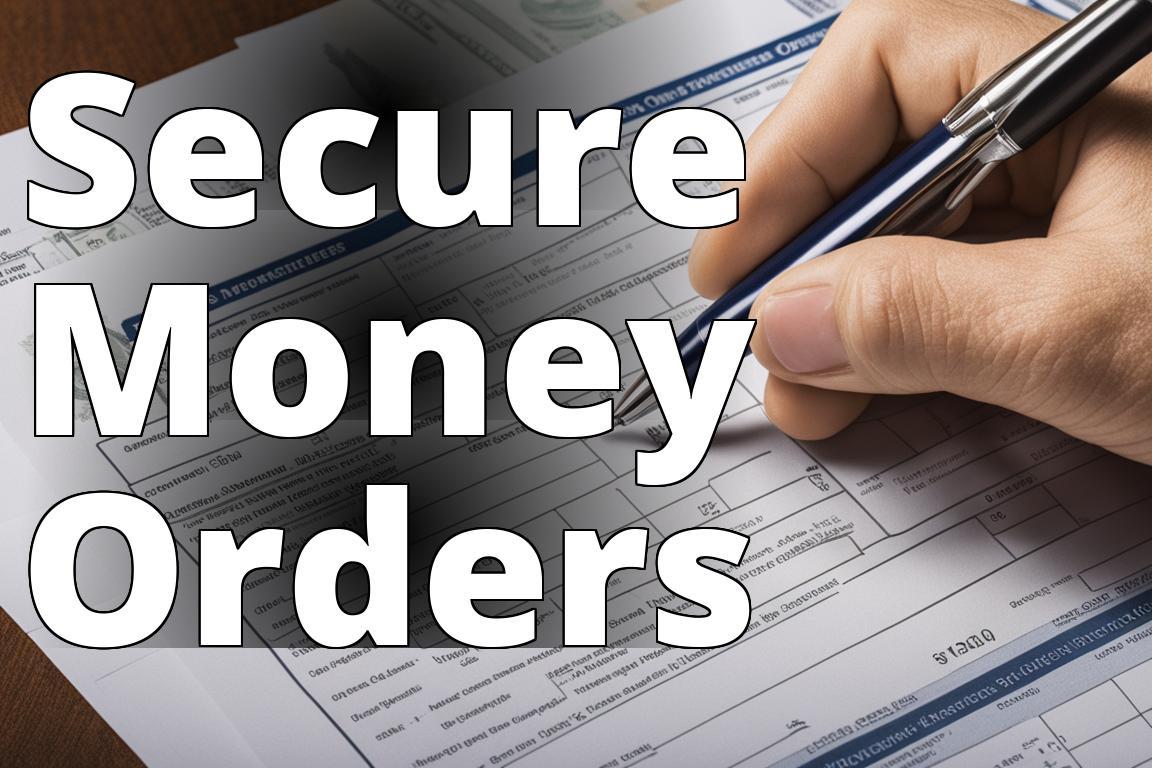Forget what you’ve heard about the decline of paper-based payments in our digital world; money orders continue to be a stalwart of secure and reliable transactions. They serve as a crucial bridge between the traditional banking system and the needs of those who prefer or require an alternative form of payment. In a financial landscape dominated by digital transactions, money orders offer a tangible sense of security and simplicity that is hard to match. This article isn’t just a rundown; it’s an exploration into why and how money orders maintain their relevance in today’s economy, especially for those navigating their finances through institutions like Chase.
What You Need to Know About Money Orders from Chase
You will learn about getting, filling out, cashing, and protecting against fraud with money orders from Chase.
- Money orders are secure, convenient, and widely accepted.
- You can get a money order in person or online from Chase.
- You can cash a money order at a bank, credit union, check-cashing store, or the money order issuer.
Money orders are a secure payment method. They are convenient, affordable, and widely accepted.
Money orders are not just a relic of the past; they are a testament to the enduring need for accessible, secure payment methods. The beauty of a money order lies in its simplicity and reliability. When you purchase a money order, you’re essentially buying peace of mind. You’re participating in a transaction that is straightforward, traceable, and less susceptible to fraud than many modern digital payment methods.
From my personal experience, I’ve found that money orders are particularly invaluable when dealing with transactions that require a guaranteed form of payment. Whether it’s paying rent to a landlord who prefers not to handle cash or sending a secure payment across the country, money orders accomplish what many digital platforms cannot provide a universally accepted form of payment without the need for a bank account or credit check.
How to get a money order
In person
Getting a money order in person is akin to a rite of passage in the financial world. It’s a process that combines the tactile satisfaction of handling physical currency with the security of a bank-issued check. Major retailers, post offices, and, of course, banks like Chase offer money orders. The process is disarmingly simple: you provide the funds plus a small fee, and in return, you receive a piece of paper that functions much like cash, but with far greater security.
I remember my first time purchasing a money order at a Chase branch. The sense of security I felt, knowing that my payment would reach its destination without the risks associated with cash or personal checks, was a revelation. It’s a service that, despite the convenience of online options, retains its appeal for many due to its inherent reliability and simplicity.
Online
While in-person transactions offer a certain level of satisfaction, the digital age has made obtaining money orders online an equally viable option. Services like MoneyGram and Western Union allow you to purchase money orders with a few clicks. This method is particularly appealing for those who value convenience or may not have easy access to a physical location.
However, it’s essential to exercise caution and ensure you’re using a reputable service, as the online realm is not without its risks. Despite these challenges, the ability to purchase a money order from the comfort of your home is a testament to how this financial instrument has evolved while maintaining its core appeal.
Some people often wonder if you can purchase money orders with gift cards and usually you cannot purchase a money order directly with a gift card. Here are some of the reasons why:
- Money orders must be purchased with guaranteed funds – either cash, debit card, or traveler’s check. Gift cards are not considered “guaranteed” since they could potentially be declined at the time of purchase.
- Most major retailers and grocery stores, like Walmart or USPS where you can purchase money orders, have policies not to accept gift cards for any financial products like money orders or prepaid debit cards.
- If the gift card has a Visa/Mastercard/Amex logo, some stores may allow using the gift card to purchase a money order. However, there will likely be additional fees. And many gift cards have terms restricting their use only for buying merchandise and services.
- If there is no Visa/Amex logo, stores have no way to process an electronic transaction with the gift card towards purchasing the money order.
How to fill out a money order
Filling out a money order is straightforward, but it’s a process that demands attention to detail. The essential information includes the recipient’s name, your address, and the amount. It’s imperative to fill out these sections accurately to ensure the money order is valid and reaches the right hands. A common mistake is rushing through this process, leading to errors that can complicate or delay the transaction.
I’ve always appreciated this step for its ritualistic quality, reminiscent of writing a check but with the added security that the money order won’t bounce. It’s a reminder of the tangible aspects of financial transactions in an increasingly virtual world.
How to cash a money order
At a bank or credit union
Cashing a money order at a bank or credit union is often the most straightforward method, especially if you have an account at the institution. Banks like Chase are well-equipped to handle money orders, offering a seamless process for depositing or cashing them. This convenience is particularly beneficial for those who regularly deal with money orders, providing a secure and efficient way to access funds.
At a check-cashing store
While banks offer convenience, check-cashing stores provide an alternative for those without a bank account or in need of immediate cash. These establishments specialize in cashing money orders, among other financial services. However, they often charge higher fees than banks, which is a crucial consideration for anyone looking to cash a money order.
At the money order issuer
Another option is to cash the money order directly at the issuer, such as a post office or retail store that offers money order services. This approach can be convenient and sometimes offers lower fees than other methods. However, availability and hours may vary, making it less accessible for some.
How to avoid money order fraud
Money order fraud is a pervasive issue, exploiting the trust and reliability typically associated with this payment method. It’s crucial to purchase money orders from reputable sources and be wary of accepting them from strangers, especially in transactions where authenticity is hard to verify. Always inspect a money order for signs of tampering or forgery before accepting it.
My advice is to treat money orders with the same caution as any financial transaction. Verify the issuer’s information, and if something feels off, trust your instincts and verify its authenticity. The Federal Trade Commission provides resources and guidelines for identifying and reporting suspected fraud, which I’ve found invaluable in navigating these waters safely.
Can You Deposit Money Orders?
Most ATMs do not accept money orders for deposits. Here are some key points about depositing money orders at ATMs:
- ATMs are designed to accept cash and checks for deposit, not money orders. They do not have the capability to scan, read or verify money orders.
- Even ATMs that accept check deposits will not be able to process money orders. Money orders must be deposited with a bank teller.
- You need to deposit a money order into your bank account at a bank branch. You would need to either mail it to your bank or deposit it at the teller in person.
- Some banks allow mobile check deposit of money orders using your banking app’s check scanning feature. However, ATMs themselves do not offer any money order deposit functionality.
You will have to check this guide on depositing money orders at Chase ATM to review their policies.
Real-Life Case Study: Avoiding Money Order Fraud
I learned the hard way about the importance of being cautious when dealing with money orders. A few years ago, my friend Sarah received a money order for $500 as payment for a used phone she sold online. Excited about the sale, she quickly deposited the money order into her bank account and transferred the funds to the buyer. However, a week later, the bank notified Sarah that the money order was counterfeit, and she was responsible for the $500.
This experience taught me that it’s crucial to verify the authenticity of a money order before depositing or cashing it. I now always recommend that individuals receiving money orders should take them directly to the issuing agent’s location to cash them, rather than depositing them into a bank account. Additionally, I advise people to be cautious of money orders received as payment for goods sold online, and to consider using secure online payment methods instead.
Being vigilant about money order fraud can save you from potential financial loss and stress.
Money order fees and limits
The convenience and security of money orders come at a cost, albeit a relatively low one. Fees vary depending on the issuer but generally range from under a dollar to a few dollars per money order. Likewise, money orders have maximum limits often $1,000 per order which can be a limitation for larger transactions.
Despite these fees and limits, money orders remain a cost-effective and secure payment method, especially for those who do not have access to traditional banking services or prefer not to use personal checks or cash. It’s a small price to pay for the peace of mind and reliability that money orders provide.
In conclusion, money orders stand as a testament to the enduring need for secure, accessible, and reliable forms of payment. Whether you’re navigating the process for the first time or a seasoned user, understanding how to effectively use money orders can add a valuable tool to your financial arsenal. They bridge the gap between digital and physical payment methods, offering a solution that is both timeless and adaptable to the needs of today’s economy.
Common Questions
Q: What is a money order from Chase?
A: A money order from Chase is a secure payment method, similar to a check, that can be used to make payments or send funds to someone.
Q: How do I get a money order from Chase?
A: To get a money order from Chase, you can visit a Chase branch and purchase one with cash or a debit card.
Q: Who can use a money order from Chase?
A: Anyone can use a money order from Chase, whether you have a Chase account or not, to securely send funds or make payments.
Q: What if I don’t have a Chase account?
A: Even if you don’t have a Chase account, you can still purchase a money order from Chase and use it for your financial transactions.
Q: How secure are money orders from Chase?
A: Money orders from Chase are secure and can be tracked if lost or stolen, providing peace of mind for both the sender and the recipient.
Q: What are the fees for a money order from Chase?
A: Chase typically charges a small fee for purchasing a money order, which may vary depending on the amount and location.




